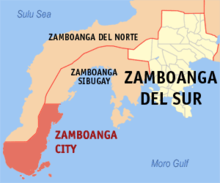This article has multiple issues. Please help improve it or discuss these issues on the talk page. (Learn how and when to remove these messages)
|
| Zamboanga City Crisis | |||||||||
|---|---|---|---|---|---|---|---|---|---|
| Part of the Moro conflict | |||||||||
 Location of Zamboanga City | |||||||||
| |||||||||
| Belligerents | |||||||||
|
|
| ||||||||
| Commanders and leaders | |||||||||
| Units involved | |||||||||
| |||||||||
| Strength | |||||||||
| |||||||||
| Casualties and losses | |||||||||
|
Note:
| |||||||||
The Zamboanga City crisis (Filipino: Krisis sa Zamboanga; Chavacano: Crisis na Zamboanga) or Zamboanga Siege was an armed conflict in Zamboanga City, Philippines between the government forces of the Philippines and Moro rebels from the Moro National Liberation Front (MNLF) that began on September 9, 2013 and ended twenty days later on September 28. The conflict began when MNLF rebels, under the command of Nur Misuari, attempted to occupy several coastal communities in Zamboanga City in protest of the Philippine government's failure to implement the 1996 final peace agreement with the MNLF.
The conflict resulted in the displacement of 120,000 civilians and the destruction of 10,000 homes. More than 200 people were killed, mostly MNLF rebels along with 20 soldiers, 5 policemen and 13 civilians.[12] The fighting also damaged Zamboanga City's airport and seaport.
- ^ "Zamboanga crisis is over, Palace: Zamboanga crisis is over". ABS-CBN News. Reuters. September 28, 2013. Archived from the original on September 29, 2013. Retrieved September 28, 2013.
- ^ Wenceslao, Bong O. (September 19, 2013). "Ravages of war". Sun Star Cebu. Retrieved September 19, 2013.
- ^ Placido, Dharel (September 24, 2013). "MNLF commander, 7 Misuari followers nabbed in Zambo". ABS-CBN News. Retrieved September 26, 2013.
- ^ "Day 18: Phl flag itinaas sa pinagkutaan ng MNLF". Bombo Radyo Philippines. September 26, 2013. Retrieved September 26, 2013.
- ^ "Nur Misuari waning influence?". [Agora Business Intelligence]. September 19, 2012. Retrieved October 7, 2013.
- ^ News reports usually refer to this group as the "MNLF-Misuari Faction," which is but an inaccurate use of term or an erroneous branding because it can be mistaken as "Pro-Misuari MNLF Faction," that observes The One MNLF Doctrine Archived October 8, 2013, at archive.today. It includes the Mindanao Independence Movement (MIM) Archived October 8, 2013, at archive.today under John Petalcorin and the Special Forces of the Bangsamoro Armed Forces (BAF-SF) composed of Mindanawons (Christians, Muslims and Lumads sharing Mindanao and Palawan as territories) under the Unified Command of General Rodrigo Fabillon, advocating independence through peaceful and legal means. Hence, it is not proper to tag the rogue faction of MNLF in Zamboanga siege as MNLF-Misuari Faction so to respect those Pro-Misuari groups that abhor violence and advocate peaceful and legal means to achieve their goals
- ^ a b c "End to Zamboanga threat, but concern for Philippines displaced". Radioaustralia.net.au (September 29, 2013). Retrieved on November 5, 2013.
- ^ Roel Pareño (September 28, 2013). "Zamboanga standoff over". The Philippine Star. Retrieved September 29, 2013.
- ^ a b Gerg Cahiles (September 30, 2013). "Troops in high morale as Zamboanga siege ends". Solar News. Retrieved October 6, 2013.
- ^ a b c 15 rebels killed in dawn raid. Philstar.com (September 28, 2013). Retrieved on November 5, 2013.
- ^ Lopez, Alexander D. (September 11, 2013). "UN, OIC intervention sought to end Zamboanga crisis". Manila Bulletin. Retrieved September 26, 2013.
- ^ "Zamboanga City remembers infamous 2013 siege, honors 38 heroes". RAPPLER. September 9, 2022. Retrieved April 22, 2023.